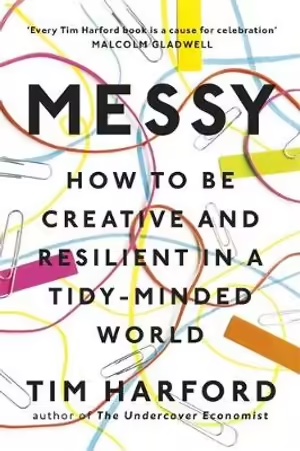“How to be creative and resilient in a tidy minded world”
I was attracted to this book because I like my spaces minimal and organised, but I sometimes struggle to maintain them in that way. So I wondered if there was something in my messiness…
Creativity and disruption
The discussion on disruption was intriguing. The work on Flow state centres on removing distractions, to allow you to go deep into a topic. By focusing on the present, and only what’s in front of you, you can achieve some of the best and most rewarding experiences of working and creating. I’ve enjoyed this zone, and try to pursue it regularly; Harford suggests that creativity is also about looking for inspiration in new places; about being open to what’s going on around you, and drawing inspiration from that. These two ideas aren’t antithetical, but I’d not thought about how to reconcile them before.
So, perhaps it’s about where and when you let messy creativity happen; about having an open curiosity about the world, which informs your ideas and perspective, and then when it’s time to transform those ideas into a thing: a blog post, a final report, a marketing pitch, you focus your concentration on producing that clear output.
The idea that having more than one ‘project’ on the go – and switching between them to help you cross fertilize ideas – is compelling; it goes with the subconscious processing that can bring on lightbulb or shower thoughts.
It also means when you’re stuck you can shift gears – goes with time blocking – knowing when you should set out to do certain tasks; high cognitive load ones when you’re at your best, more processing ones when you need something relatively straightforward to do. And when you’re doing other things – simple tasks, lightly focusing on something else, often the answer you’ve been searching for will come to you. I know I’m not the only one to solve problems on easy runs, or while in the shower!
“Having another project to turn to can prevent a setback from turning into a crushing experience”
Flexibility
Another concept that came through strongly in Messy was the idea of being flexible, being prepared for a bit of improvisation, paired with confidence
It takes confidence to not have everything 100% planned (a speech, a presentation, a workshop format)- and that this can actually make for a better outcome, if you’re able to pick up on how the audience is responding, and let that help inform where you go next. Working a little on the fly like this depends on the context – I’ve never done a TedTalk, but they are 100% polished! And I think it’s important to have some parts of what you’re going to say very clear (and practicing the words can help). But I’ve also run workshops and collaborative sessions where I’ve had an idea of the overall goal or outcome, but not necessarily a clear understanding of the exact activities or questions I’m going to run. Working in this way takes a confidence that you can come up with the right questions – and I’ve found the best way to do this is to stay present in the conversation, synthesizing and organising as you go, to identify themes to focus on. It takes a lot of concentration, trust in your own ability and, probably, buy in from the group you’re working with. So I wouldn’t recommend it in every situation!
This idea of flexibility also struck me because I know my usual state is to do a lot of planning, setting out frameworks, understanding the whole context before diving in. I love a good plan! But I’ve also never met a project Gannt chart that has played out exactly as written. Over time, I’ve learnt that the key is to be constantly evaluating as you go; asking where are we now? And, what’s the next step we need to take? Rather than trying to plan out every step. For this to work requires a clear articulation of the end goal, and faith in your creative ability to come up with the step that needs to happen next.
It’s a balance – I’m not suggesting don’t think through, play out, pressure test your thinking – but don’t let some unattainable idea of perfection get in the way of progress.
Collaboration in teams
This is a topic I’m always curious about – how to create high performing teams. Tidy teams enjoy their time together – they are friendly and think they are coming up with the right answers – but in reality messy teams, where there’s a bit of conflict and diverse thinking actually came up with better ideas.
Successful teams are prepared to challenge each other’s ideas, to sit in the slight discomfort of disagreement, in the pursuit of good answers; they value the intellectual stoush over comfortable conversation. This has implications for choices we make about the diversity of our teams; we are usually drawn to people like us. Again, it’s a balance – there needs to be a common value placed on getting to a robust answer – but a willingness to have your views challenged, and perhaps change your mind along the way.
The book also contemplates how we can think about a messy approach to winning, incentives, automation and resilience, but I’ll leave them for another post – it might not be 100% neat but I’m embracing the messy concept here!
A messy life
The final section on integrating messiness into life I found compelling. I’m definitely guilty of trying to overorganise things – spending too much time sorting information rather than getting on with delving into solutions. He notes that there are always many different ways of categorising things, and so one system of organising information (think your email inbox) will ever be perfect. As a side note, this is why I love using Roam Notes – you can tag each note with as many categories as you like, meaning it’s super easy to find information and no need for over structuring and organising.
It also has some insights into time planning and goal setting – finding that a monthly approach to planning was most effective, moreso than daily or weekly approaches. This is thought to be the case because a month long period allows for the uncertainties of every day life to be accounted for. The other end of this spectrum is time blocking which takes almost the polar opposite view – setting out chunks of time to work on specific tasks.
As with most of these concepts, in my view it comes down to context – what work are you do, and what’s the best framework for managing that. And then, sticking with a system – consistency trumps searching for perfection.
Which is an interesting segue into the book’s section on online dating, which I think is neatly summarised with this quote “When it comes to finding someone who can make us happy… the qualities we want are altogether harder to define.” A-men to that!
In summary…
I found this book informative and thought provoking. It challenged my thinking, but also gave me solace, and set me free from the idea that my life would be easier/ better/ more productive/ if only I was better organised. I am still completely sold on the idea that one of life’s biggest challenges is articulating exactly what it is that we want. And I used to think that once you had done that, it was then a matter of figuring out each and every step to get there. What this book helped me do was have faith that having a goal is still important, but that being more flexible and open to what you discover along the way is also crucial – and that inevitably the goal will change. And that’s actually the best part. It also helped confirm for me a myth that I think I’d had from an early age – there is an ‘end point’ in our lives, when everything is neat, sorted…that we are fixed. It really is about the journey. The path, if you will.





